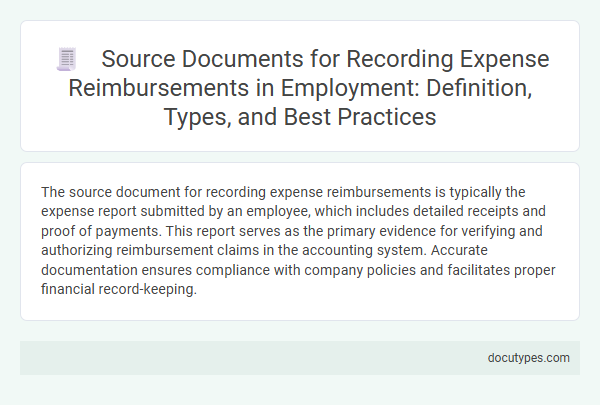The source document for recording expense reimbursements is typically the expense report submitted by an employee, which includes detailed receipts and proof of payments. This report serves as the primary evidence for verifying and authorizing reimbursement claims in the accounting system. Accurate documentation ensures compliance with company policies and facilitates proper financial record-keeping.
Introduction to Expense Reimbursement Source Documents
Expense reimbursement source documents are essential records that verify your business-related expenses. These documents provide proof for reimbursing employees or tracking company expenditures.
Common types of source documents include receipts, invoices, and credit card statements. Accurate documentation helps maintain transparent financial records and ensures compliance with company policies.
Definition of Source Documents in Employment Expense Claims
Source documents for recording expense reimbursements in employment are original records that validate the expenditures made by employees. These documents include receipts, invoices, and payment proofs, which serve as evidence for the financial transaction. Accurate source documents ensure proper accounting and compliance in processing expense claims.
Importance of Accurate Record-Keeping for Reimbursements
The source document for recording expense reimbursements is typically the original receipt or invoice that verifies the expenditure. Accurate record-keeping of these documents is crucial for maintaining financial transparency and ensuring proper reimbursement.
Proper documentation helps prevent errors and fraud in expense claims, protecting both the employer and employee. Your financial records must be precise to comply with tax regulations and internal audit requirements.
- Receipts and Invoices - These provide proof of the expenses incurred and are essential for validating reimbursement requests.
- Expense Reports - These summarize and itemize expenses along with corresponding receipts for organizational tracking.
- Compliance Verification - Keeping accurate records ensures adherence to company policies and legal tax obligations.
Common Types of Source Documents for Expense Reimbursements
Source documents for recording expense reimbursements serve as the official proof for expenses incurred by employees on behalf of an organization. These documents ensure accurate accounting and facilitate audit trails for financial transparency.
- Receipts - Physical or digital receipts from vendors showing detailed transaction information are the most common source documents for expense reimbursement.
- Invoices - Official bills issued by service providers or suppliers listing the goods or services provided and their costs are essential for validating reimbursement claims.
- Expense Reports - Employee-submitted forms summarizing expenses with attached supporting documents function as a consolidated source for processing reimbursements.
Receipts: Content and Compliance Requirements
Receipts serve as the primary source document for recording expense reimbursements in employment settings. They provide detailed evidence of transactions, ensuring accuracy and compliance in financial records.
- Itemized Details - Receipts must include a clear description of purchased goods or services to validate the expense.
- Date and Amount - Accurate recording of the transaction date and total amount spent is essential for reimbursement processing.
- Compliance Requirements - Receipts should meet company policy standards and legal regulations to be considered valid proof of expense.
Properly maintained receipts support transparent financial management and simplify audit procedures.
Invoices and Their Role in Expense Documentation
What is the source document for recording expense reimbursements? Invoices serve as primary source documents for expense reimbursements, providing detailed evidence of costs incurred. They include critical information such as date, amount, vendor, and description of goods or services, ensuring accurate and verifiable expense tracking.
Electronic vs. Paper Source Documents: Pros and Cons
| Source Document Type | Advantages | Disadvantages |
|---|---|---|
| Electronic Source Documents |
|
|
| Paper Source Documents |
|
|
| Your choice of source document impacts accuracy and efficiency in recording expense reimbursements. Electronic documents streamline processes but demand robust security measures. Paper documents offer simplicity but entail risks related to handling and storage. | ||
Best Practices for Collecting and Storing Source Documents
The source document for recording expense reimbursements is typically the original receipt or invoice provided by the vendor. These documents serve as proof of the expenses incurred and are essential for accurate accounting.
Best practices for collecting and storing source documents involve obtaining clear, legible receipts immediately after transactions. You should organize these documents systematically, either digitally or physically, to ensure easy retrieval during audits or reviews. Maintaining a consistent filing system helps prevent loss and supports compliance with company policies and tax regulations.
Audit Considerations: Ensuring Document Authenticity
The source document for recording expense reimbursements typically includes receipts, invoices, and approved expense reports that validate the expenses incurred. Audit considerations focus heavily on ensuring the authenticity of these documents to prevent fraud and maintain accurate financial records. You must verify signatures, dates, and supporting details to confirm that reimbursements are legitimate and properly authorized.
What Is the Source Document for Recording Expense Reimbursements? Infographic

